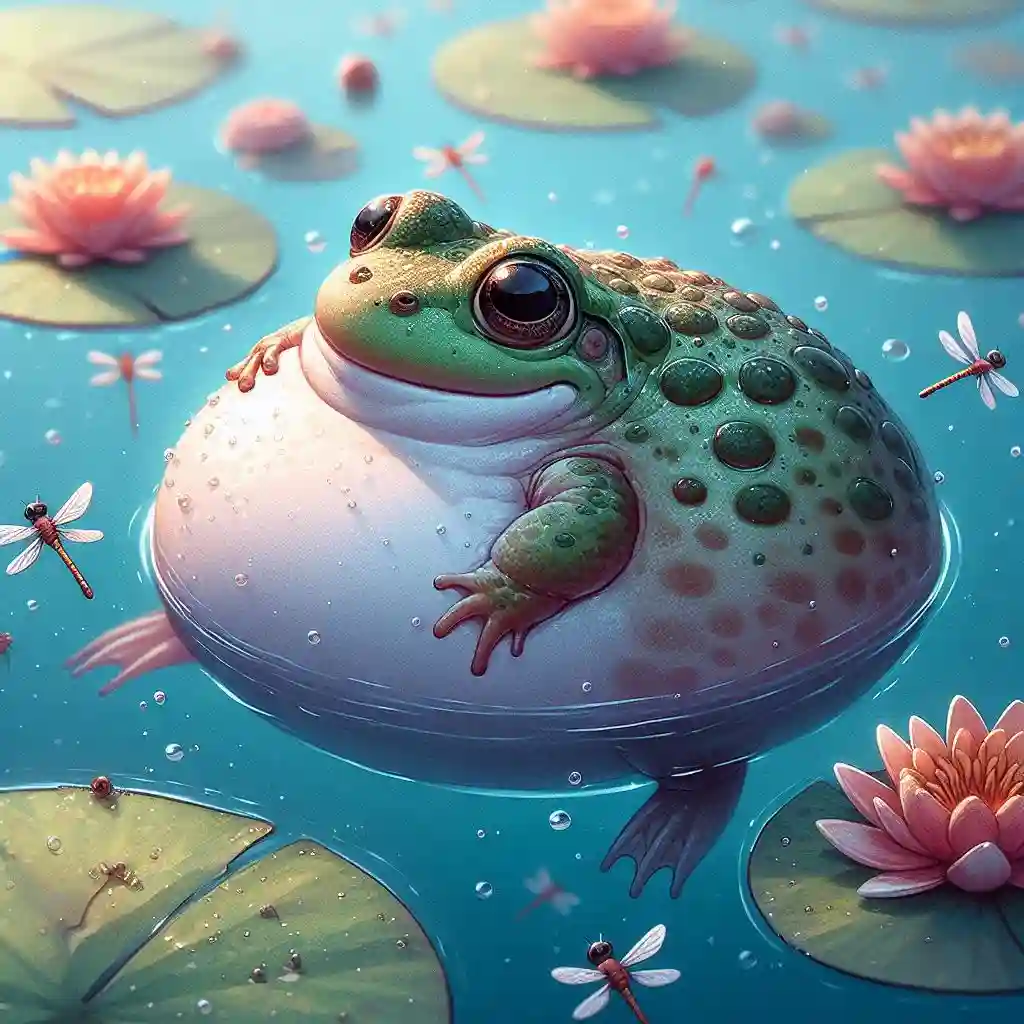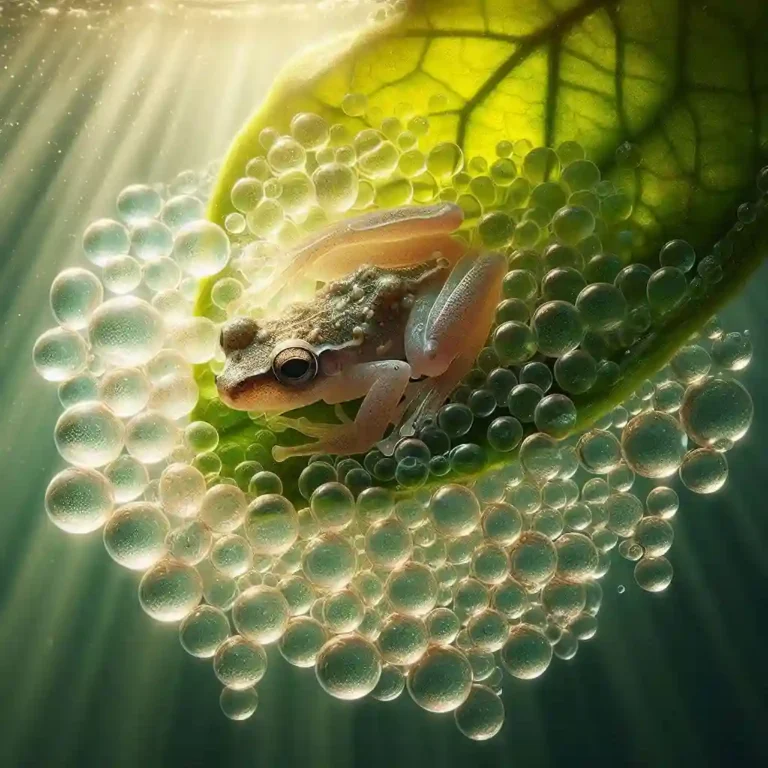Bloated African Dwarf Frog: Symptoms, Causes, and Treatment
Bloated African Dwarf Frog: African Dwarf Frogs are known for their playful antics and endearing nature, but when they start to balloon up like a tiny, green beach ball, it’s a sign that something is amiss.
Bloating in African Dwarf Frogs can be a symptom of an underlying issue, and if left unchecked, can lead to serious health complications.
In this article, we’ll take a closer look at the causes of bloating, how to identify the warning signs, and most importantly, what you can do to help your frog regain its natural, slender physique.
Bloated African Dwarf Frog: A Quick Guide

Causes of bloating in African Dwarf Frogs:
- Diet: Overfeeding or eating too much food can lead to bloating.
- Environment: Poor water quality, inadequate tank size, or lack of hiding places can contribute to bloating.
- Health issues: Underlying health issues, such as kidney or liver disease, can also cause bloating.
Symptoms of bloating in African Dwarf Frogs:
- Swollen abdomen
- Lethargy
- Loss of appetite
- Changes in skin color or texture
Treatment for bloating in African Dwarf Frogs:
- Dietary changes: Providing a balanced and nutritious diet can help alleviate bloating.
- Environmental adjustments: Improving water quality, increasing tank size, and providing hiding places can help reduce bloating.
- Medication: In some cases, medication may be necessary to treat underlying health issues.
Prevention of bloating in African Dwarf Frogs:
- Providing a balanced and nutritious diet
- Maintaining a clean and well-maintained environment
- Monitoring health regularly
What is Bloating in African Dwarf Frogs?
Bloating in African Dwarf Frogs refers to a condition where the frog’s body becomes abnormally swollen, often due to an accumulation of fluids or gases in the body cavity. This can cause the frog’s abdomen to become distended, leading to a range of health problems if left untreated.
Physical Characteristics of Bloating:
- Visible swelling of the abdomen, which may be soft and squishy to the touch
- Enlargement of the frog’s body, which can be noticeable even to the naked eye
- Lethargy and reduced activity levels, as the frog may become uncomfortable or painful due to the bloating
- Changes in appetite, as the frog may lose interest in food or have difficulty eating due to discomfort or pain
Why is Bloating a Concern?
Bloating in African Dwarf Frogs can be a sign of an underlying issue, such as a digestive problem, infection, or environmental factor. If left untreated, bloating can lead to more severe health complications, including:
- Respiratory distress, as the swollen abdomen can put pressure on the frog’s lungs
- Infection or sepsis, if the bloating is caused by a bacterial or fungal infection
- Malnutrition, as the frog may have difficulty eating or absorbing nutrients due to discomfort or pain
Common Causes of Bloating in African Dwarf Frogs

1. Overfeeding
- Feeding your frog too much food can lead to bloating, as the excess nutrients can cause the frog’s body to retain water and swell.
2. Poor Water Quality
- Poor water quality can cause stress and discomfort in your frog, leading to bloating. This can be due to factors such as:
- High levels of ammonia or nitrite
- Low oxygen levels
- Incorrect water temperature or pH
3. Constipation
- Constipation can cause bloating in African Dwarf Frogs, as the frog’s digestive system becomes blocked or slowed.
4. Gut Infections
- Bacterial or fungal infections in the gut can cause bloating, as the infection can lead to inflammation and fluid buildup.
5. Respiratory Infections
- Respiratory infections can cause bloating, as the frog’s body may retain fluid in response to the infection.
6. Kidney or Liver Disease
- Underlying kidney or liver disease can cause bloating, as the organs may not be functioning properly, leading to fluid retention.
7. Impaction
- Impaction, where food or other material becomes stuck in the frog’s digestive tract, can cause bloating.
8. Genetic Predisposition
- Some African Dwarf Frogs may be more prone to bloating due to genetic factors.
9. Environmental Stress
- Environmental stress, such as changes in temperature, humidity, or lighting, can cause bloating in African Dwarf Frogs.
10. Nutritional Deficiencies
- Nutritional deficiencies, such as a lack of essential vitamins or minerals, can contribute to bloating in African Dwarf Frogs.
Dietary Factors: How Food Can Contribute to Bloating

1. Overfeeding
- Feeding your frog too much food can lead to bloating, as the excess nutrients can cause the frog’s body to retain water and swell.
2. High-Protein Diets
- Diets high in protein can cause bloating, as the frog’s body may have difficulty digesting and processing the excess protein.
3. Low-Fiber Diets
- Diets low in fiber can cause constipation, which can lead to bloating.
4. Foods High in Salt
- Foods high in salt can cause water retention, leading to bloating.
5. Foods High in Sugar
- Foods high in sugar can cause digestive issues, leading to bloating.
6. Inadequate Calcium
- Inadequate calcium in the diet can lead to metabolic bone disease, which can cause bloating.
7. Vitamin and Mineral Imbalances
- Imbalances of vitamins and minerals, such as vitamin A or potassium, can contribute to bloating.
8. Feeding Live Foods
- Feeding live foods, such as live brine shrimp or bloodworms, can cause bloating if the foods are not properly gut-loaded or if the frog is not able to digest them properly.
9. Inadequate Gut Loading
- Inadequate gut loading of live foods can lead to nutrient deficiencies, which can contribute to bloating.
10. Lack of Variety
- A diet lacking in variety can lead to nutrient deficiencies and bloating.
Environmental Triggers: How Tank Conditions Can Cause Bloating
1. Poor Water Quality
- High levels of ammonia, nitrite, or nitrate can cause stress and bloating in African Dwarf Frogs.
- Inadequate water changes or filtration can lead to poor water quality.
2. Inadequate Water Temperature
- Water temperatures that are too high or too low can cause stress and bloating in African Dwarf Frogs.
- Temperature fluctuations can also contribute to bloating.
3. Inadequate Humidity
- Low humidity can cause dehydration, which can lead to bloating in African Dwarf Frogs.
- High humidity can also cause respiratory issues, which can contribute to bloating.
4. Inadequate Lighting
- Inadequate lighting can cause stress and bloating in African Dwarf Frogs.
- Lighting that is too intense or too dim can also contribute to bloating.
5. Overcrowding
- Overcrowding in the tank can cause stress and bloating in African Dwarf Frogs.
- Inadequate space can lead to competition for resources and territorial behavior, which can contribute to bloating.
6. Poor Tank Maintenance
- Inadequate tank maintenance, such as infrequent water changes or cleaning, can lead to poor water quality and bloating.
- Failure to clean the tank regularly can also contribute to bloating.
7. Inadequate Hiding Places
- Inadequate hiding places can cause stress and bloating in African Dwarf Frogs.
- Hiding places can help reduce stress and provide a sense of security, which can help prevent bloating.
8. Inadequate Water Circulation
- Inadequate water circulation can lead to stagnant water, which can cause bloating in African Dwarf Frogs.
- Poor water circulation can also contribute to poor water quality.
Signs and Symptoms of Bloating in African Dwarf Frogs
Visible Signs:
- Swollen Abdomen: A visibly swollen abdomen is one of the most obvious signs of bloating in African Dwarf Frogs.
- Distended Body: The frog’s body may appear distended or rounded, especially around the midsection.
- Labored Breathing: Bloating can cause respiratory distress, leading to labored breathing or rapid breathing.
Behavioral Changes:
- Lethargy: Bloating can cause African Dwarf Frogs to become lethargic or inactive.
- Loss of Appetite: Frogs may lose their appetite or show a decreased interest in food.
- Changes in Posture: Frogs may adopt an unusual posture, such as arching their back or lying on their side.
Other Symptoms:
- Difficulty Swimming: Bloating can make it difficult for frogs to swim or move around comfortably.
- Changes in Skin Color: The skin may appear pale, dull, or discolored due to bloating.
- Increased Mucous Production: Frogs may produce excess mucous or have a thick, sticky coating on their skin.
How to Diagnose Bloating in Your African Dwarf Frog
Step 1: Observe Your Frog’s Behavior
- Monitor your frog’s behavior, appetite, and activity level.
- Look for signs of lethargy, loss of appetite, or changes in posture.
Step 2: Perform a Physical Examination
- Gently handle your frog to check for any visible signs of bloating, such as a swollen abdomen or distended body.
- Check for any changes in skin color, texture, or mucous production.
Step 3: Take a Complete Medical History
- Provide your veterinarian with a detailed medical history of your frog, including:
- Diet and feeding habits
- Environmental conditions (tank size, temperature, humidity, lighting)
- Any changes in behavior or appetite
- Any previous illnesses or health issues
Step 4: Conduct Laboratory Tests
- Your veterinarian may perform the following tests to rule out other potential causes of bloating:
- Complete Blood Count (CBC) to check for signs of infection or inflammation
- Blood chemistry tests to evaluate kidney and liver function
- Urinalysis to check for signs of kidney disease or infection
- Imaging studies (e.g., X-rays or ultrasound) to visualize the frog’s internal organs
Step 5: Rule Out Other Conditions
- Your veterinarian will rule out other potential causes of bloating, such as:
- Infections (bacterial, fungal, or parasitic)
- Kidney disease
- Liver disease
- Gastrointestinal obstruction or impaction
- Cancer
Step 6: Develop a Treatment Plan
- Based on the diagnosis, your veterinarian will develop a treatment plan to address the underlying cause of bloating.
- Treatment may involve dietary changes, medication, or other interventions to manage the condition.
Treatment and Recovery: Helping Your Frog Get Back to Normal
Step 1: Provide a Healthy Diet
- Offer a balanced and nutritious diet that includes a variety of foods, such as live or frozen/freeze-dried foods.
- Avoid overfeeding, as this can exacerbate bloating.
Step 2: Maintain a Healthy Environment
- Ensure the tank is clean and well-maintained, with proper water quality and temperature control.
- Provide a comfortable and stress-free environment with adequate hiding places and visual barriers.
Step 3: Monitor Your Frog’s Progress
- Keep a close eye on your frog’s behavior, appetite, and physical condition.
- Monitor for any signs of improvement or worsening of the condition.
Step 4: Consider Medication or Supplements
- In some cases, medication or supplements may be necessary to help manage bloating.
- Consult with a veterinarian experienced in amphibian care to determine the best course of treatment.
Step 5: Provide Adequate Rest
- Allow your frog to rest and recover from the stress of bloating.
- Avoid handling or disturbing your frog excessively.
Step 6: Follow Up with Your Veterinarian
- Schedule follow-up appointments with your veterinarian to monitor your frog’s progress and adjust treatment as needed.
Step 7: Prevent Future Episodes
- Take steps to prevent future episodes of bloating by maintaining a healthy diet, environment, and monitoring your frog’s behavior and physical condition.
Preventing Bloating in the Future: Tips for a Healthy Frog
1. Maintain a Healthy Diet
- Feed your frog a balanced and nutritious diet that includes a variety of foods.
- Avoid overfeeding, as this can lead to bloating.
2. Keep the Tank Clean
- Regularly clean the tank to prevent the buildup of waste and bacteria.
- Change the water regularly to maintain good water quality.
3. Monitor Water Quality
- Check the water quality regularly to ensure it’s safe for your frog.
- Perform regular water changes to maintain good water quality.
4. Provide Adequate Space
- Ensure your frog has enough space to move around comfortably.
- Avoid overcrowding, as this can lead to stress and bloating.
5. Reduce Stress
- Minimize stress by providing a comfortable and peaceful environment.
- Avoid handling your frog excessively, as this can cause stress.
6. Monitor Your Frog’s Health
- Keep an eye on your frog’s behavior, appetite, and physical condition.
- Consult with a veterinarian experienced in amphibian care if you notice any signs of illness or stress.
7. Consider a Bloating Prevention Supplement
- Consult with a veterinarian experienced in amphibian care about using a bloating prevention supplement.
- These supplements can help prevent bloating by promoting digestive health and reducing stress.
8. Keep the Tank Well-Ventilated
- Ensure good air circulation in the tank to prevent the buildup of stale air.
- Avoid using filters that can create stagnant air.
9. Avoid Overheating
- Keep the tank at a comfortable temperature between 65-75°F (18-24°C).
- Avoid placing the tank near direct sunlight or heat sources.
10. Consult with a Veterinarian
- Consult with a veterinarian experienced in amphibian care for personalized advice on preventing bloating.
- They can help you develop a plan to keep your frog healthy and bloating-free.
FAQs
Q: What causes bloating in African Dwarf Frogs?
A: Bloating in African Dwarf Frogs can be caused by a variety of factors, including diet, environment, and health issues.
Q: What are the symptoms of bloating in African Dwarf Frogs?
A: Symptoms of bloating in African Dwarf Frogs can include a swollen abdomen, lethargy, loss of appetite, and changes in skin color or texture.
Q: How is bloating diagnosed in African Dwarf Frogs?
A: Bloating in African Dwarf Frogs is typically diagnosed through a combination of physical examination, laboratory tests, and medical history.
Q: How is bloating treated in African Dwarf Frogs?
A: Treatment for bloating in African Dwarf Frogs typically involves dietary changes, environmental adjustments, and in some cases, medication.
Q: Can bloating be prevented in African Dwarf Frogs?
A: Yes, bloating can be prevented in African Dwarf Frogs by maintaining a healthy diet, providing a clean and well-maintained environment, and monitoring their health regularly.
Q: How can I prevent bloating in my African Dwarf Frog?
A: To prevent bloating in your African Dwarf Frog, make sure to provide a balanced and nutritious diet, maintain a clean and well-maintained environment, and monitor your frog’s health regularly.
Q: What should I do if my African Dwarf Frog is experiencing bloating?
A: If your African Dwarf Frog is experiencing bloating, consult with a veterinarian experienced in amphibian care for proper diagnosis and treatment.
Q: Can bloating be fatal in African Dwarf Frogs?
A: Yes, bloating can be fatal in African Dwarf Frogs if left untreated. It is essential to seek veterinary care if you suspect your frog is experiencing bloating.

Hello, I’m Aria Cooper, the heart and soul behind Swimmy Buddies. As a devoted fish aficionado, I share my aquatic adventures and expertise to inspire your own underwater explorations. 🐠🌊


